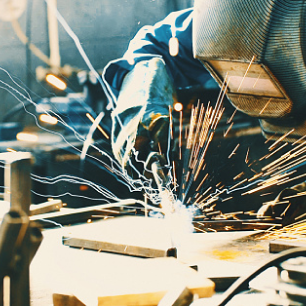Jump to:
Combining Phased Array Ultrasonic Testing and Time-of-Flight Diffraction to Increase Productivity
In the contemporary landscape of economic models, the prevalence of the just-in-time manufacturing approach has induced a profound transformation. This shift places immense pressure on the supply chain to attain efficiency. Tasks that do not directly contribute to an immediate escalation in production throughput often incur the disdain of upper management. Within this context, material welding introduces a conundrum wherein nondestructive examination (NDE) is begrudgingly acknowledged, at best, as a necessary inconvenience and, at worst, as an adversary of productivity. This article explores technologies that exert far less disruption on welding production.
Current Situation
One of the predominant inspection methods employed in welding applications is radiographic testing (RT), which has held its ground for decades in verifying the weld integrity of manufactured equipment and structures. As a well-established volumetric nondestructive inspection approach, RT enjoys widespread endorsement from major inspection codes and certifying bodies worldwide, boasting a documented history of effectively detecting volumetric flaws such as porosities. While its merits are widely recognized, so too are its drawbacks. One notable challenge lies in using radioactive sources, necessitating the clearance of the weld vicinity to mitigate radiation safety concerns. This clearance requirement, undoubtedly disruptive to production, often prompts inspections to be relegated to night shifts when the premises are unoccupied. Additionally, the traditional film-based RT requires film processing, leading to a considerable time gap between the inspection procedure and the final determination of weld acceptance or rejection.
Replacement Option
With the continuous evolution of codes and standards, a shift from conventional film radiography to advanced ultrasonic testing has garnered significant attention for both manufacturing and in-service inspection of welds (Ref. 1). Beyond the evident safety advantages over RT, this transition also brings about heightened productivity and reduced implementation costs, driving the swift adoption of alternative ultrasonic techniques (Ref. 2).
The current pinnacle of this progression involves phased array ultrasonic testing (PAUT) and time-of-flight diffraction (TOFD) (Ref. 3). The synergy between these methods presents a robust and dependable approach to weld inspection. The amalgamation of these techniques guarantees a high probability of defect detection and precise sizing. It retains flexibility in addressing practical challenges frequently encountered in the field, such as unconventional joint geometries or minor deviations from nominal specifications (Ref. 4).
This volumetric inspection technique offers two principal advantages in contrast to the established conventional film RT method. First, it eliminates radiation hazards. Second, the analysis results are swiftly accessible, allowing NDE teams to collaborate seamlessly with welding crews. This real-time feedback mechanism aids productivity by minimizing the occurrence of subpar welds.
Over the past decade, PAUT and TOFD have conclusively proven their worth as alternatives to RT across various weld inspection applications and global markets, receiving recognition from multiple certifying bodies. Notably, each technique has distinct strengths concerning the types of defects it’s most attuned to. RT excels in detecting volumetric flaws such as porosities or slags, whereas PAUT outperforms RT in identifying planar defects such as cracks. Consequently, a meticulous assessment of the inspection technique should ideally be performed on a case-by-case basis.
While it’s possible to perform PAUT and TOFD inspections sequentially, concurrently utilizing these methods offers many advantages that make any other approach counterproductive. This approach not only enhances the efficiency of inspection crews by minimizing the number of scans and manipulations required but also significantly impacts data quality. Sequential application often challenges maintaining identical mechanical references, such as scan starting positions and offsets from the weld center line. This variance can lead to imprecise indication positioning. Additionally, using different scanners for PAUT and TOFD, each with distinct encoder calibrations, might result in inaccuracies in length sizing of indications.
However, practically implementing simultaneous PAUT and TOFD is a more complex endeavor than it may appear. Let’s discuss the numerous challenges inherent in effectively executing such an inspection while examining a recently developed system to address these challenges.
Technique Combination Challenges
PAUT and TOFD techniques require distinct hardware and software requisites tailored to each method. While the market offers various inspection systems dedicated solely to PAUT or TOFD, concurrently, the scarcity of options excelling in both techniques is evident. Addressing these technique-
specific disparities presents challenges, particularly concerning operator training and proficiency.
An intriguing challenge arises from the dissimilarities between PAUT and TOFD techniques — the expertise of a PAUT-focused operator might not seamlessly extend to calculating precise probe-center separation (PCS) values for specific TOFD configurations nor to accurately interpreting TOFD data. Similarly, an adept TOFD operator might encounter difficulties configuring sectors or electronic scans for PAUT. Consequently, a typical inspection scenario involves the involvement of two specialized operators.
The complexity of a scanning device accommodating the concurrent application of PAUT and TOFD is noteworthy. At a minimum, the scanner must accommodate four search units comprising two PA probes and a TOFD pair. However, as the material thickness increases, TOFD inspections necessitate multiple depth zones, entailing more TOFD probes and an expanded PCS to cover the volume of interest comprehensively. To optimize inspection efficiency, particularly when assessing thin-wall and heavy-wall components within a single shift, the scanner must offer flexibility to cater to a wide range of thicknesses. This adaptability enhances the effectiveness of the inspection team, contributing to streamlined operations.
A Portable System with Embedded Software
A portable PAUT and TOFD system that combines both techniques with embedded software and a versatile modular scanner represents a solution. The TOPAZ® product family (Fig. 1) and Gekko® (Fig. 2) are battery-operated systems that handle various applications.
One of the main software improvements of this inspection platform is the visual feedback integrated into setup creation — Fig. 3. The onboard calculator simplifies the development of a comprehensive scan plan and evaluating volume coverage, encompassing even the heat-affected zone. In contrast, the initial-generation systems necessitate executing this phase within PC-based software and transferring it manually to the embedded system.
Reporting remains a pivotal task of the inspection process. Modern software platforms allow users to generate an indication table swiftly and produce customizable, print-ready PDF reports. Data analysts can now pick information for inclusion in reports — from hardware settings and scan plans to indication specifics — and also append personalized fields.
Modular Scanner
During an inspection campaign, the size and geometry of the welds can vary a lot. To maximize the efficiency of the inspection crew, the scanner used for the simultaneous use of PAUT and TOFD needs to adapt to as many inspection configurations as possible — Fig. 4.
The basic LYNCS scanner kit allows the two-sided inspection of circumferential welds from nominal pipe size four (NPS 4) and up, and up to two in. for thicknesses. Its compact design allows it to operate in clearances as low as 4.3 in., increasing its application range. The adjustable tensioning system of the four probe holders allows adequate coupling to the inspection surface in all conditions.
For thicknesses larger than two in., the TOFD inspection is usually performed in more than one zone. Therefore, when used simultaneously with PAUT, more than four probe holders are required. Also, larger PCS values are required to cover the bottom of the volume of interest. Optional extension kits are available to extend the range of applicability of the scanner for thicknesses up to six in. When axial welds need to be inspected, the scanner can be converted using an optional mechanical part. In its axial configuration, the scanner allows the inspection of longitudinal seam welds.
Conclusion
Substituting PAUT and TOFD for RT in weld inspection eradicates radiation hazards and facilitates prompt feedback to the welding team. This can enhance production rates while reducing expenses related to substandard outputs. The simultaneous use of PAUT and TOFD is a compelling inspection method for welded joints.
Works Consulted
- Frost & Sullivan. 2013. Replacement of radiography by phased array ultrasonic testing drives global ultrasonic NDT equipment market, analysis of the global ultrasonic non-destructive test equipment market. Mountain View, Calif.
- Chauveau, D., Blettner, A., Cadith, J., and Rivenez, J. 2011. Comment, pratiquement, améliorer la radioprotection des opérateurs CND par l’utilisation d’autres méthodes et/ou techniques? COFREND, Dunkerque, France.
- Hatsch, J., Chauveau, D., and Blettner, A. 2008. Méthodes alternatives à la gammagraphie à l’Iridium, projet alter-X. COFREND, Toulouse, France.
- Laprise, F., Berlanger, J., and Maes, G. 2012. Sectorial scan PAUT combined with TOFD, a robust weld inspection technique in lieu of RT. 18th Conference on Nondestructive Testing, Durban, South Africa.


